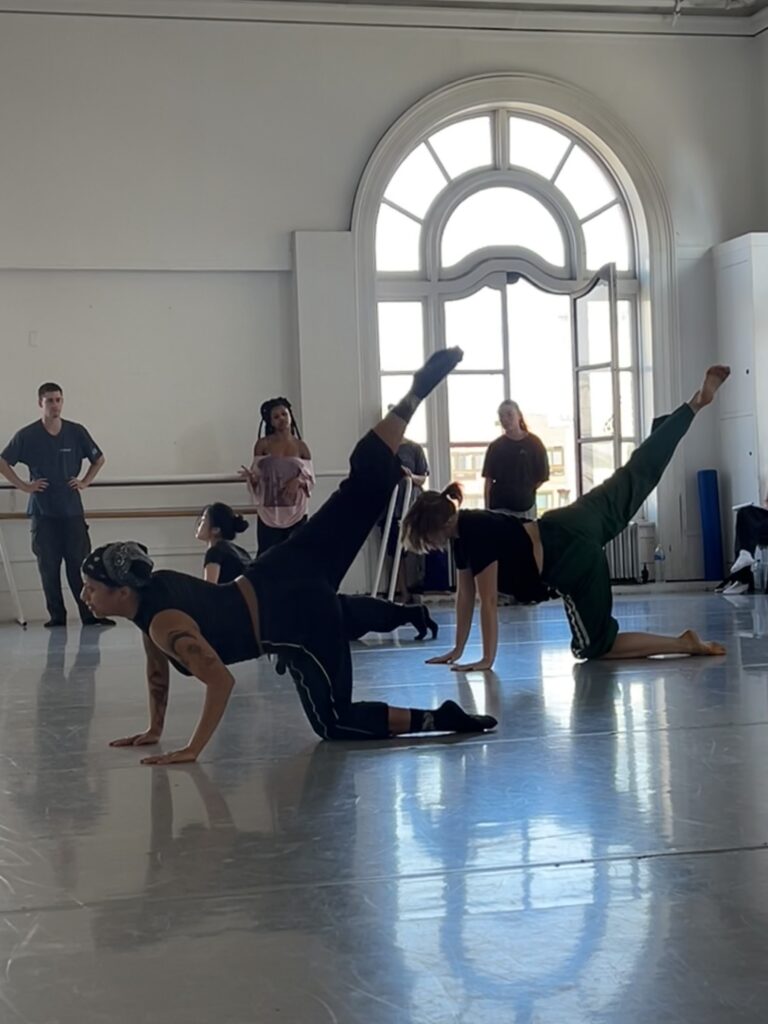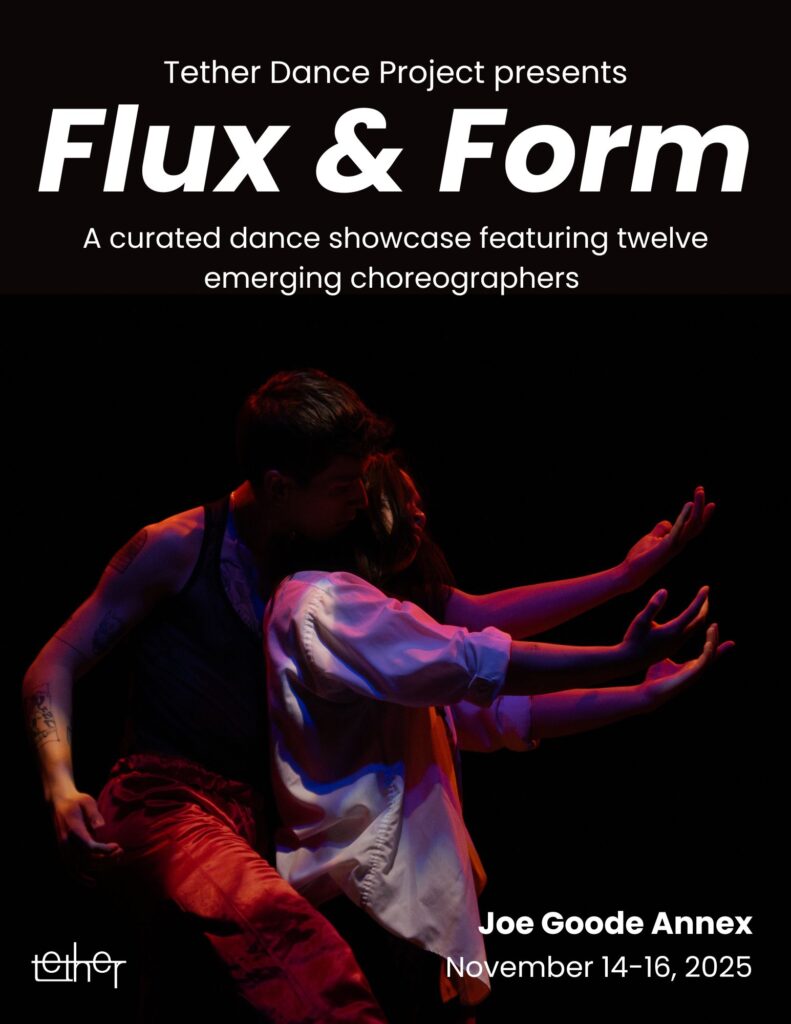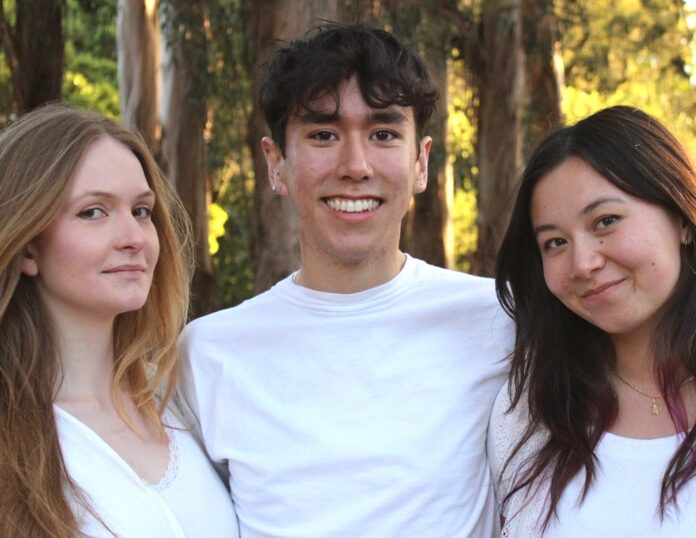On September 27, young dancers, each in their own world, warmed up to prepare for the day’s event in studio one of LINES Dance Center. “Ignite,” a joint dance and movement workshop and panel organized by two local companies, Tether Dance Project and Pearl Street Dance Collective, was born of a need for connection and guidance among local young emerging artists at this time, a space its organizers wanted to create for both themselves and attendees.
Tatianna Steiner, Ella Wright, and Teo Lin-Bianco, all recent UC Berkeley alums and co-founders and directors of Tether Dance Project, have faced difficulties finding opportunities as young graduates. Auditions are often invite-only and the companies with open auditions generally are looking for more mature, mid-career artists. As the Trump Administration continues to reduce funding for the arts, artistic directors are more likely to hire artists they know to be reliable from working with them in the past, rather than taking a chance on someone new.
“There wasn’t really any communal gathering in order to meet people like me who are also facing the same struggles,” said Steiner. “We just really wanted to offer something that we would have liked to have.”

“Ignite” began with Tether’s co-directors and Pearl Street Collective director Elizabeth Wiehe asking attendees to gather in a circle and share how they were feeling. Many of the dancers, dressed in different combinations of warmups—sweat pants, oversized shirts, and socks— admitted to being nervous but excited. Wiehe reminded the group, which totaled 16 after a few latecomers arrived, that they were all there to “dance with each other and uplift.”
After Steiner and Teo Lin-Bianco led a warmup that doubled as a way for the dancers to gain comfortability in the space and with each other, Wright taught 64 counts of a piece premiered last spring by Tether, Strides. Once attendees had learned the choreography, which had an airy quality of being suspended in the clouds, they were split into smaller groups, with Steiner, Wright, Lin-Bianco, and Wiehe also dancing. Cheers erupted before and after every group.
This spirit of support continued with Wiehe teaching an excerpt from a piece premiered in Pearl Collective’s recent show, The Rule of Thirds. This movement was higher energy and more grounded. Bounding from the upstage left corner of the room, Wiehe didn’t count the dancers in or use a specific track that would prompt them to start. Instead, she asked them to move as one by feeling each other out.
To close the movement portion of the workshop, the dancers were divided into groups of three and given an experimental exercise of using the previously learned sections of choreography to either pull from directly or mirror or gesture in some way to create a new short work. The groups went from concentrated conversation, to laughing as they tried to piece things together. High fives and “yassss,” echoed through the studio just before each group gave a mini-performance of what they came up with in the 15 minutes they had to prepare. The other dancers sat at the front of the room, clapping and cheering.
The workshop closed how it started, a circle forming around panelists SanSan Kwan, Chair of UC Berkeley Theater, Dance, and Performance Studies; Stacey Printz, Director of Printz Dance Project; and Erin Yen, director of Dragon Dance, in a circle. They reflected on their challenges as artists, the turning point in their careers, their ideal collaborator, what kind of dancer they seek in an audition, financial difficulties, and handling rejection.
Printz encouraged attendees to try new classes, even when unsure if it will be a good fit. “There might be a choreographer there doing something interesting or different that I haven’t tried yet. Finding connection that way, I think, is great,” said Printz.
She also spoke to the importance of not saying yes to everything. “It’s so easy at the early stages, but I think it kind of moves all of us to be mindful of doing work that we need and that we’re curious and excited about…which isn’t saying you don’t want to try stuff out, right? But then from a point of knowledge where you’re like, oh I’m glad it did it and moving forward, I probably wouldn’t work with that company again,” said Printz.
Yen, an artist earlier in her career than Kwan and Printz, echoed the importance of risk-taking, as well as trusting one’s individuality. “There’s only one you and as an artist, that’s been tough for me to take on. For example, there’s only one Britney Spears, and maybe I want to be like Britney Spears, but there’s only one Britney. So I can only bring my own art into the world, and if I keep following my gut and trusting my own space and doing what I’m interested in, I can only hope that the world is big enough to allow space for my own individuality,” said Yen.
Workshop attendee Hadassah Levi signed up because she saw the event as a chance to connect, grow, and feel supported. “Ignite was everything and more—I’m so grateful for the opportunity to train and collaborate in that space. It was truly refreshing and inspiring,” she said.

Tether Dance Project is facilitating opportunities both in the studio on stage for young artists. Tether’s upcoming Flux and Form, a curated showcase featuring 12 emerging choreographers, is happening November 14-16 at the Joe Goode Annex. It will premiere nine original works choreographed and performed by artists across movement practices and backgrounds, each piece more largely focused on how these artists can stay grounded in their values amid ongoing challenges within the field.
Matt Barry, a queer interdisciplinary performance artist, will share a self choreographed solo called Honk, Boom, Bam. The piece is centered on their work in drag which is also based in the world of clownery and plays with surrealist themes. Barry was introduced to Steiner and Lin-Bianco because they all teach at Rae Studios. They were excited to learn about the showcase and applied to their open call.
“There’s so many people who want to have a piece and a stake in the game, and who want to share their ideas and create art that’s meaningful. That’s why I think that Tether and with Flux and Form, is a great place for emerging artists to not only connect and network with each other, because it’s going to be kind of the next evolution, or the next generation of dancers and art makers, but it also gets us to start creating and cultivating our voices so that we can present it to more places,” said Barry.
Lily Gee, a choreographer and dancer, will present a reimagined piece of a previous work, performing with five fellow dancers. Gee reflected on the challenges of creating work and having performance opportunities outside of the structure of a college or larger academic institution.
“We all danced in college or did some sort of certificate dance program at a dance center, if not in college, post high school. So that was like regular performances every semester, fully produced for us and just given the opportunity to create work, and it didn’t even have to be a fully formed idea before we actually got in the rehearsals,” said Gee.
Gee met Steiner in an open audition. “It’s really beautiful to have the opportunity to expand our communities… to see these young people pave the way.”
The Tether team was overwhelmed by the number of applications they received for the showcase, making it a challenge to choose who would be invited. They hope to make it an annual production moving forward. “Emerging artists are always coming out of college, joining the Bay. And it’s important to us that we are upholding that for every new generation, every new year,” said Lin-Bianco.
The Tether team also hopes that Flux and Form will show audiences the value of young artists today. “We really want people to take away that our voices matter and that it’s meaningful and is just as valuable as the work and art of mid-career artists or late-career artists,” said Steiner.
FLUX AND FORM, November 14-16 at Joe Goode Annex, SF. More info here.




